Linux 高并发服务器实战 - 3 Linux多线程开发
线程概述
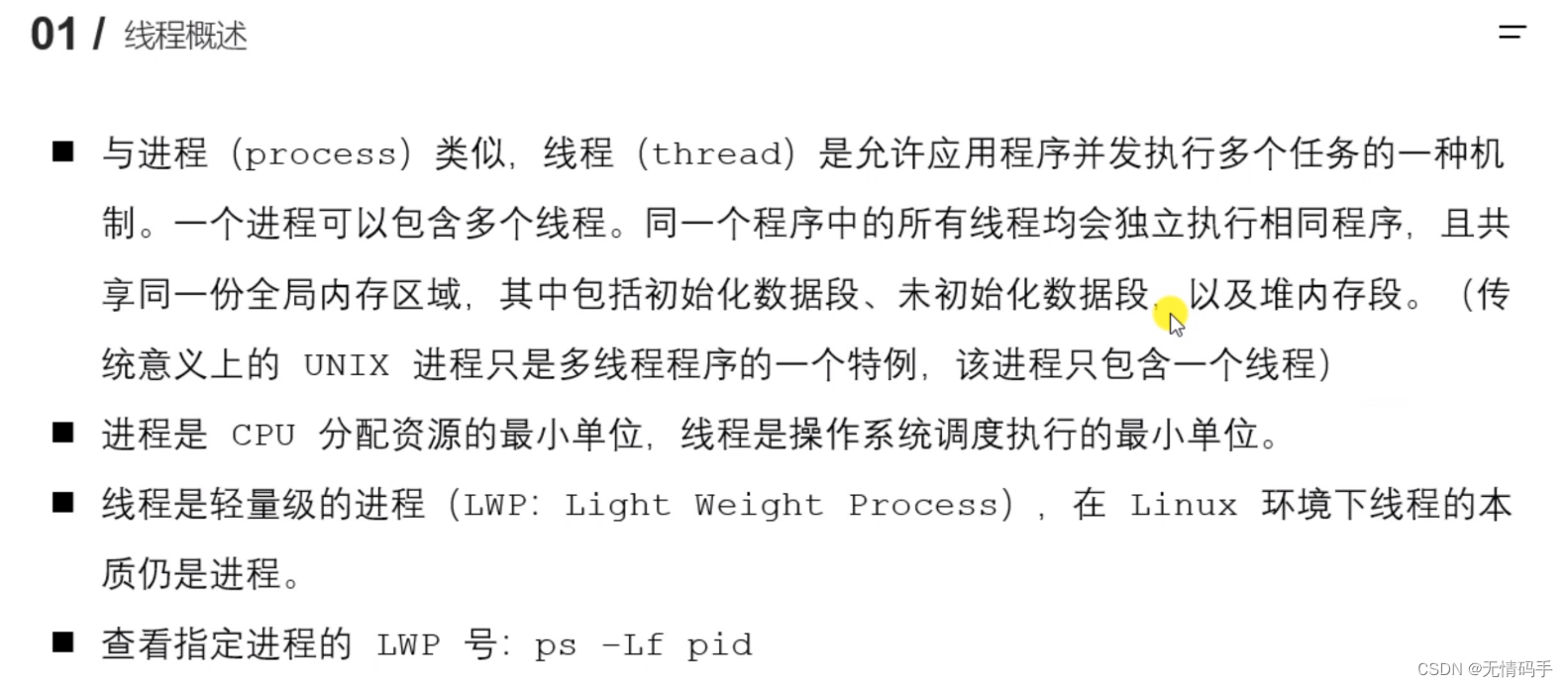
进程是CPU分配资源的最小单位,线程是操作系统调度执行的最小单位
线程是轻量级的进程(LWP:Light Weight Process),在Linux 环境下线程的本质仍然是进程
查看指定进程的LWP号:ps -ls pid
线程共享一份全局内存区域 其中包括初始化数据段、未初始化数据段、堆内存段
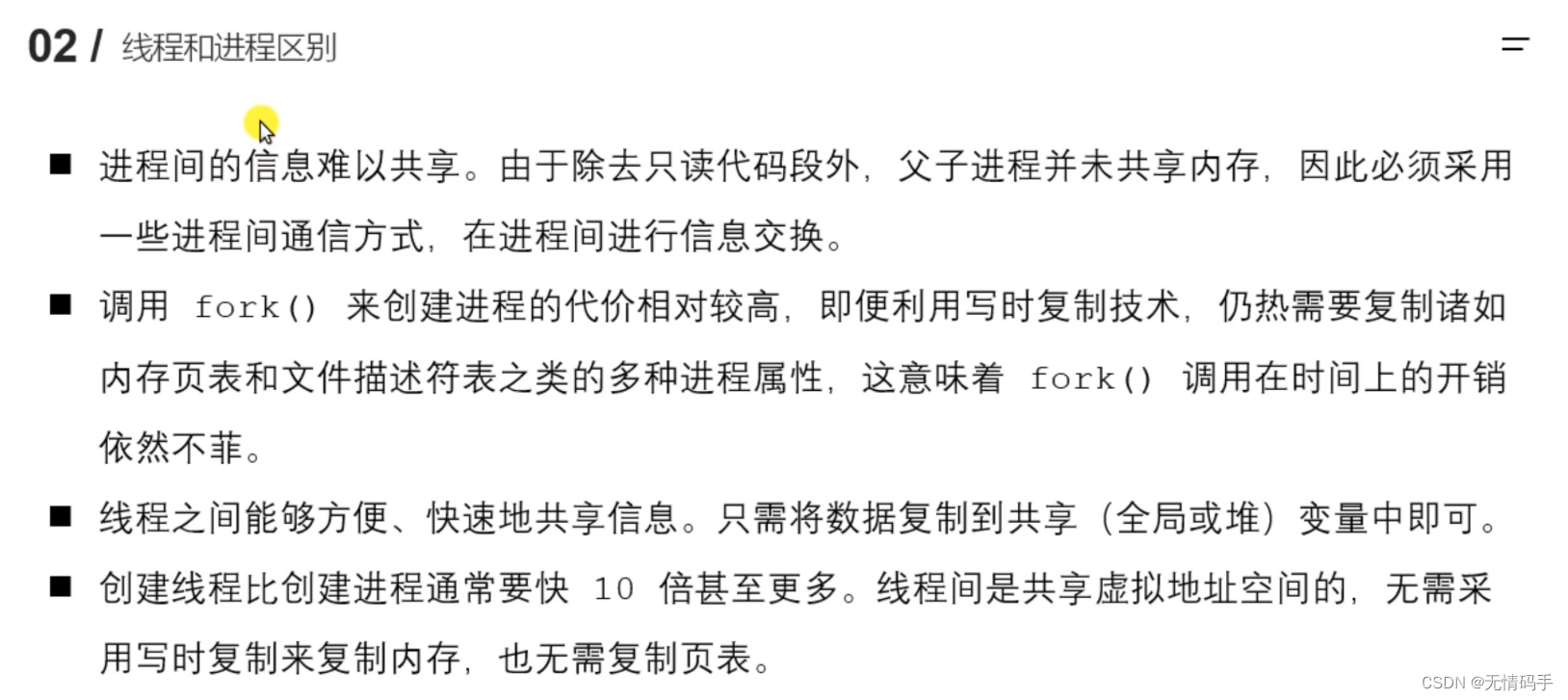
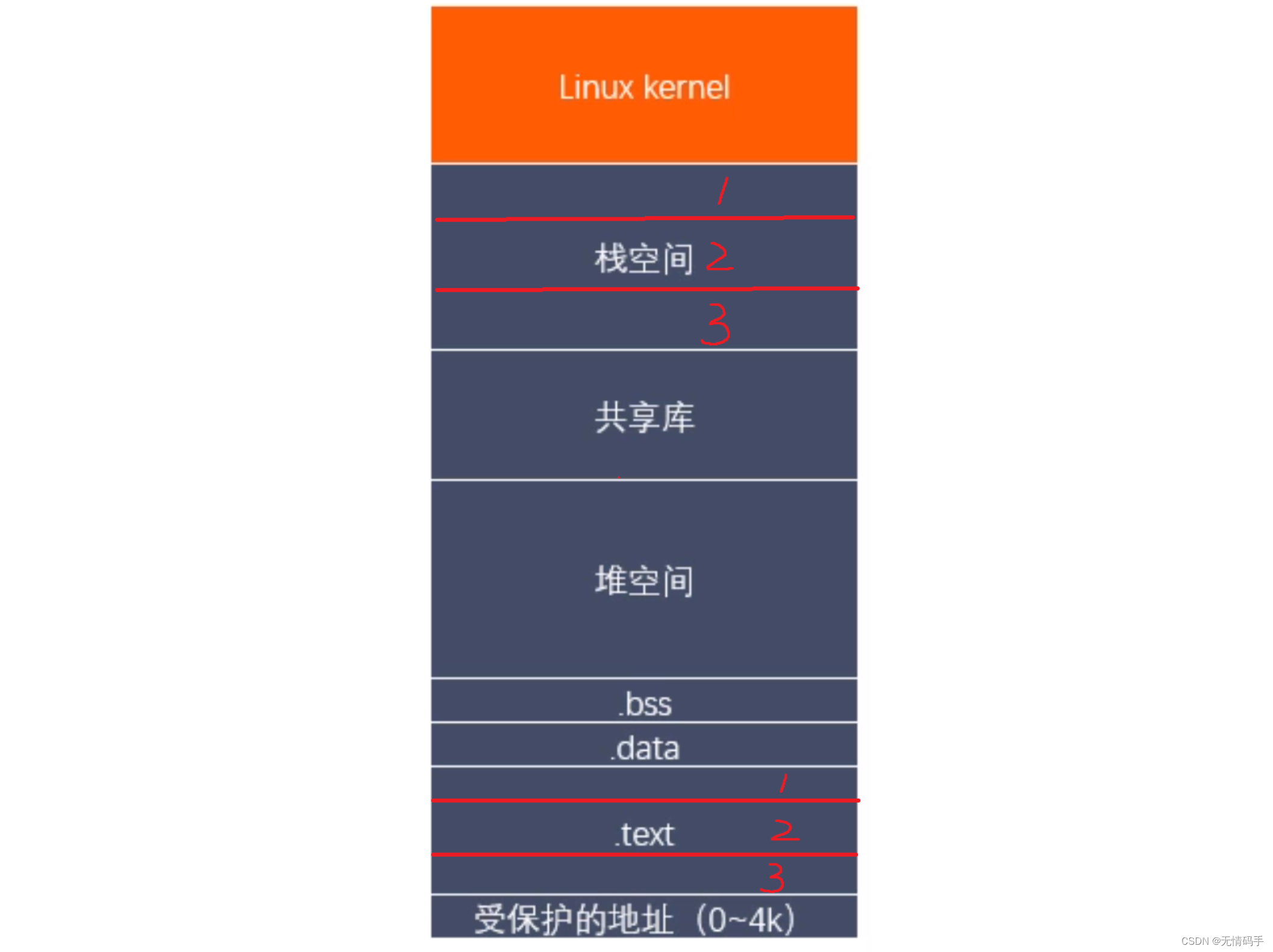
不同线程拥有不同的代码段、拥有不同的栈空间,其余 共享库、堆空间、是共享的
线程没有创建新的虚拟地址空间,因此它内核区里的大部分资源都是共享的,至于用户区里的,有两部分:栈、代码段不共享
信号掩码->阻塞信号集、未决信号集

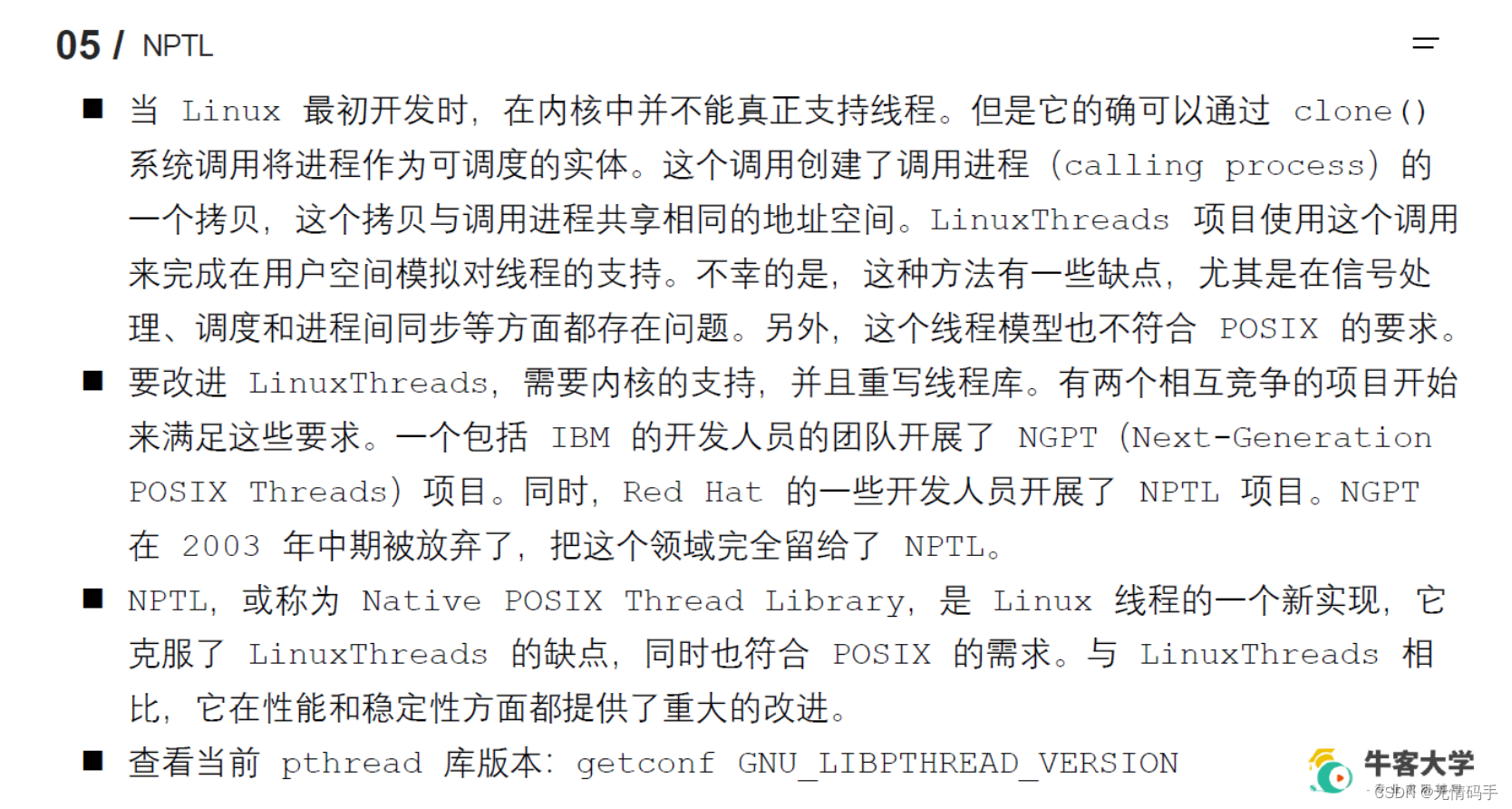
进程fork() 时的代价还是蛮高的,虽然是写时共享,但是一但写时,需要大量操作
可以把一个进程的程序,看成是一个线程的程序。
一般情况下,main函数所在的线程我们称之为主线程(main 线程),其余创建的线程称之为子线程
程序中默认只有一个线程,pthread_create()函数调用,就有了两个线程
注意函数指针的类型是void* 参数类型也是void*
#include <pthread.h>
int pthread_create(pthread_t *thread, const pthread_attr_t *attr,
void *(*start_routine) (void *), void *arg);
- 功能:创建一个子线程
- 参数:
- thread:传出参数,线程创建成功后,子线程的线程ID被写到该变量中。
- attr : 设置线程的属性,一般使用默认值,NULL
- start_routine : 函数指针,这个函数是子线程需要处理的逻辑代码
- arg : 给第三个参数使用,传参
- 返回值:
成功:0
失败:返回错误号。这个错误号和之前errno不太一样。
获取错误号的信息: char * strerror(int errnum);
注意线程不是C标准库里的,在编译的时候要用-l 引入第三方库,这里可以直接用 -pthread代替
也可以-l pthread 库真正的名字是 libpthread.so
子线程执行的代码只是回调函数里的代码
只要在主线程中执行了return 0 整个进程就结束了
#include <stdio.h>
#include <pthread.h>
#include <string.h>
#include <unistd.h>
void * callback(void * arg) {
printf("child thread...\n");
printf("arg value: %d\n", *(int *)arg);
return NULL;
}
int main() {
pthread_t tid;
int num = 10;
// 创建一个子线程
int ret = pthread_create(&tid, NULL, callback, (void *)&num);
if(ret != 0) {
char * errstr = strerror(ret);
printf("error : %s\n", errstr);
}
for(int i = 0; i < 5; i++) {
printf("%d\n", i);
}
sleep(1);
return 0; // exit(0);
}
终止线程
如果主线程执行完了,直接return 0 ,子线程还没来得及执行,进程就已经结束了,这显然不对。
当主线程执行完后,我们应该让主线程退出,pthread_exit(NULL) (在谁里面调用就是让谁退出)。这样进程还会存在,不影响其他线程的执行
在子线程里return NULL 相当于pthread_exit(NULL)
#include <pthread.h>
void pthread_exit(void *retval);
功能:终止一个线程,在哪个线程中调用,就表示终止哪个线程
参数:
retval:需要传递一个指针,作为一个返回值,可以在pthread_join()中获取到。
pthread_t pthread_self(void);
功能:获取当前的线程的线程ID
int pthread_equal(pthread_t t1, pthread_t t2);
功能:比较两个线程ID是否相等
不同的操作系统,pthread_t类型的实现不一样,有的是无符号的长整型,有的
是使用结构体去实现的。
所以不能直接用 == 去做比较,如果两个都是结构体,直接比较地址肯定是不对的
#include <stdio.h>
#include <pthread.h>
#include <string.h>
void * callback(void * arg) {
printf("child thread id : %ld\n", pthread_self());
return NULL; // pthread_exit(NULL);
}
int main() {
// 创建一个子线程
pthread_t tid;
int ret = pthread_create(&tid, NULL, callback, NULL);
if(ret != 0) {
char * errstr = strerror(ret);
printf("error : %s\n", errstr);
}
// 主线程
for(int i = 0; i < 5; i++) {
printf("%d\n", i);
}
printf("tid : %ld, main thread id : %ld\n", tid ,pthread_self());
// 让主线程退出,当主线程退出时,不会影响其他正常运行的线程。
pthread_exit(NULL);
printf("main thread exit\n");
return 0; // exit(0);
}
连接已终止的线程(得到它返回的那个值,并回收子线程资源)
子进程由父进程手动地用wait回收
对于线程,它不一定要通过父线程回收,它可以由任何线程回收。一般来说是主线程回收子线程
#include <pthread.h>
int pthread_join(pthread_t thread, void **retval);
- 功能:和一个已经终止的线程进行连接
回收子线程的资源
这个函数是阻塞函数,调用一次只能回收一个子线程
一般在主线程中使用
- 参数:
- thread:需要回收的子线程的ID
- retval: 接收子线程退出时的返回值 (注意这是一个二级指针)
如果不需要接收这个返回值,那就用NULL
- 返回值:
0 : 成功
非0 : 失败,返回的错误号
子线程结束的时候是有返回值传回去的
*这里也可以 return (void )&value;
int value = 10;
void * callback(void * arg) {
printf("child thread id : %ld\n", pthread_self());
// sleep(3);
// return NULL;
// int value = 10; // 局部变量
pthread_exit((void *)&value); // return (void *)&value;
}
注意不要返回局部变量
因为局部变量是放在栈空间里的,当这个线程结束之后,栈空间就释放了,你再去通过地址去取它。它里面已经是随机数了,所以要用全局
// 主线程调用pthread_join()回收子线程的资源
// 把一级指针的地址传进去,作为参数去接收那个值,再用一级指针的一个*去访问
int * thread_retval;
ret = pthread_join(tid, (void **)&thread_retval);
if(ret != 0) {
char * errstr = strerror(ret);
printf("error : %s\n", errstr);
}
printf("exit data : %d\n", *thread_retval);
pthread_exit那边返回的是一个一级指针,如果你也传一个一级指针到pthread_join里是没法操作的
//这样你是没法改变data的值的
int data = 20
void change(int data){
data = 10;
}
//你想要改变,就得加个*
int data = 20
void change(int* data){
*data = 10;
}
change(&data);
//这样才能改变
//同样的,你想改变一级指针里的值,也需要再用一个* 用二级指针来变
// 把一级指针的地址转成二级指针,那就是二级指针啦
ret = pthread_join(tid, (void **)&thread_retval);
// 我们用:(void **)&thread_retval 去改变了 thread_retval里的值,然后再用(*thread_retval)去访问这个一级指针
#include <stdio.h>
#include <pthread.h>
#include <string.h>
#include <unistd.h>
int value = 10;
void * callback(void * arg) {
printf("child thread id : %ld\n", pthread_self());
// sleep(3);
// return NULL;
// int value = 10; // 局部变量
pthread_exit((void *)&value); // return (void *)&value;
}
int main() {
// 创建一个子线程
pthread_t tid;
int ret = pthread_create(&tid, NULL, callback, NULL);
if(ret != 0) {
char * errstr = strerror(ret);
printf("error : %s\n", errstr);
}
// 主线程
for(int i = 0; i < 5; i++) {
printf("%d\n", i);
}
printf("tid : %ld, main thread id : %ld\n", tid ,pthread_self());
// 主线程调用pthread_join()回收子线程的资源
int * thread_retval;
// 把一级指针的地址转成二级指针,那就是二级指针啦
ret = pthread_join(tid, (void **)&thread_retval);
if(ret != 0) {
char * errstr = strerror(ret);
printf("error : %s\n", errstr);
}
printf("exit data : %d\n", *thread_retval);
printf("回收子线程资源成功!\n");
// 让主线程退出,当主线程退出时,不会影响其他正常运行的线程。
pthread_exit(NULL);
return 0;
}
线程的分离
int pthread_detach(pthread_t thread);
- 功能:分离一个线程。被分离的线程在终止的时候,会自动释放资源返回给系统。
1.不能多次分离,会产生不可预料的行为。
2.不能去连接一个已经分离的线程,会报错。
- 参数:需要分离的线程的ID
- 返回值:
成功:0
失败:返回错误号
pthread_detach 之后 就不需要 pthread_join再去释放它的资源,它自己就返回给系统了
#include <stdio.h>
#include <pthread.h>
#include <string.h>
#include <unistd.h>
void * callback(void * arg) {
printf("chid thread id : %ld\n", pthread_self());
return NULL;
}
int main() {
// 创建一个子线程
pthread_t tid;
int ret = pthread_create(&tid, NULL, callback, NULL);
if(ret != 0) {
char * errstr = strerror(ret);
printf("error1 : %s\n", errstr);
}
// 输出主线程和子线程的id
printf("tid : %ld, main thread id : %ld\n", tid, pthread_self());
// 设置子线程分离,子线程分离后,子线程结束时对应的资源就不需要主线程释放
ret = pthread_detach(tid);
if(ret != 0) {
char * errstr = strerror(ret);
printf("error2 : %s\n", errstr);
}
// 设置分离后,对分离的子线程进行连接 pthread_join()
// ret = pthread_join(tid, NULL);
// if(ret != 0) {
// char * errstr = strerror(ret);
// printf("error3 : %s\n", errstr);
// }
pthread_exit(NULL);
return 0;
}
线程取消
#include <pthread.h>
int pthread_cancel(pthread_t thread);
- 功能:取消线程(让线程终止)
取消某个线程,可以终止某个线程的运行,
但是并不是立马终止,而是当子线程执行到一个取消点,线程才会终止。
取消点:系统规定好的一些系统调用,我们可以粗略的理解为从用户区到内核区的切换,这个位置称之为取消点。
系统调用的地方是 取消点,因为要切换到内核区
创建出来子线程后,下面又取消了线程,可能运行到一半就结束了
每次运行可能都不一样,遇到取消点取消
#include <stdio.h>
#include <pthread.h>
#include <string.h>
#include <unistd.h>
void * callback(void * arg) {
printf("chid thread id : %ld\n", pthread_self());
for(int i = 0; i < 5; i++) {
printf("child : %d\n", i);
}
return NULL;
}
int main() {
// 创建一个子线程
pthread_t tid;
int ret = pthread_create(&tid, NULL, callback, NULL);
if(ret != 0) {
char * errstr = strerror(ret);
printf("error1 : %s\n", errstr);
}
// 取消线程
pthread_cancel(tid);
for(int i = 0; i < 5; i++) {
printf("%d\n", i);
}
// 输出主线程和子线程的id
printf("tid : %ld, main thread id : %ld\n", tid, pthread_self());
pthread_exit(NULL);
return 0;
}
线程属性
设置属性:
pthread_attr_setxxx
PTHREAD_CREATE_DETACHED是设置线程分离
(自己释放资源)
设置线程属性让他分离:
pthread_attr_setdetachstate(&attr, PTHREAD_CREATE_DETACHED);
获取子线程栈的大小:
// 获取线程的栈的大小
size_t size;
pthread_attr_getstacksize(&attr, &size);
printf("thread stack size : %ld\n", size);
/*
int pthread_attr_init(pthread_attr_t *attr);
- 初始化线程属性变量
int pthread_attr_destroy(pthread_attr_t *attr);
- 释放线程属性的资源
int pthread_attr_getdetachstate(const pthread_attr_t *attr, int *detachstate);
- 获取线程分离的状态属性
int pthread_attr_setdetachstate(pthread_attr_t *attr, int detachstate);
- 设置线程分离的状态属性
*/
#include <stdio.h>
#include <pthread.h>
#include <string.h>
#include <unistd.h>
void * callback(void * arg) {
printf("chid thread id : %ld\n", pthread_self());
return NULL;
}
int main() {
// 创建一个线程属性变量
pthread_attr_t attr;
// 初始化属性变量
pthread_attr_init(&attr);
// 设置属性
pthread_attr_setdetachstate(&attr, PTHREAD_CREATE_DETACHED);
// 创建一个子线程
pthread_t tid;
int ret = pthread_create(&tid, &attr, callback, NULL);
if(ret != 0) {
char * errstr = strerror(ret);
printf("error1 : %s\n", errstr);
}
// 获取线程的栈的大小
size_t size;
pthread_attr_getstacksize(&attr, &size);
printf("thread stack size : %ld\n", size);
// 输出主线程和子线程的id
printf("tid : %ld, main thread id : %ld\n", tid, pthread_self());
// 释放线程属性资源
pthread_attr_destroy(&attr);
pthread_exit(NULL);
return 0;
}
线程同步
多线程和多进程都是实现并发执行!
多线程实现并发案例
查看当前线程id: pthread_self()
3个线程卖100张票
3 个线程,抢CPU并执行,抢到了就执行

(1)出现0/负数的情况
都是>0的时候进来的,然后分别休眠6000微秒,然后最先醒的是1,它–,变成了0,再醒的又–,成了-1
(2)出现卖同一张票的情况
速度非常快时,上一个线程还没走ticket–,下一个线程就打印了,卖的同一张票
多个线程,对同一个资源同时进行处理,会出现问题
对共享数据的操作,必须一个线程把这段操作的内容全部执行完了,下一个再执行。(原子操作,一个线程执行完了,另一个线程才能再操作)
临界区:对临界资源的操作,刚刚那段代码整个while就是临界区
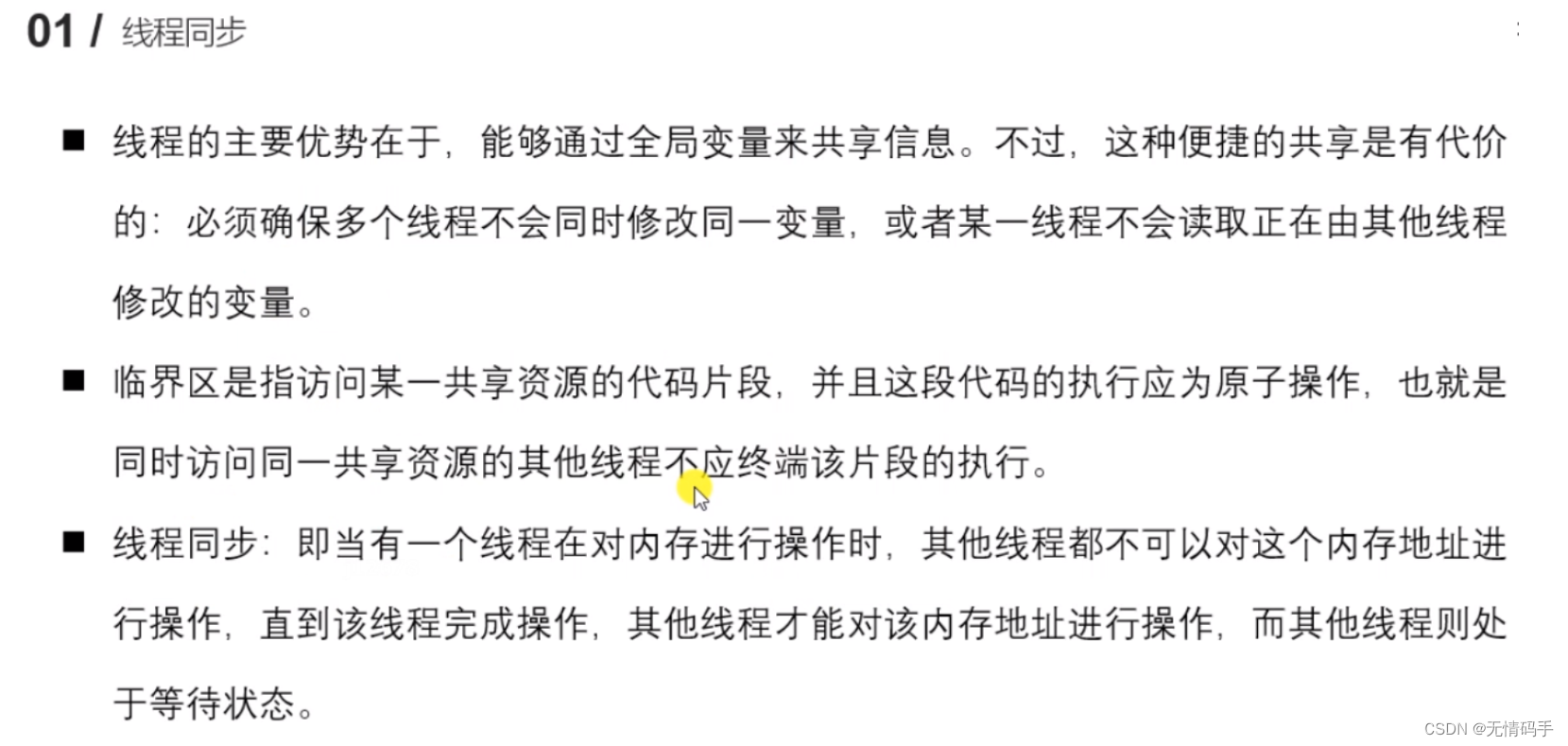
只是限制临界区那一块,对整体来说,影响不大
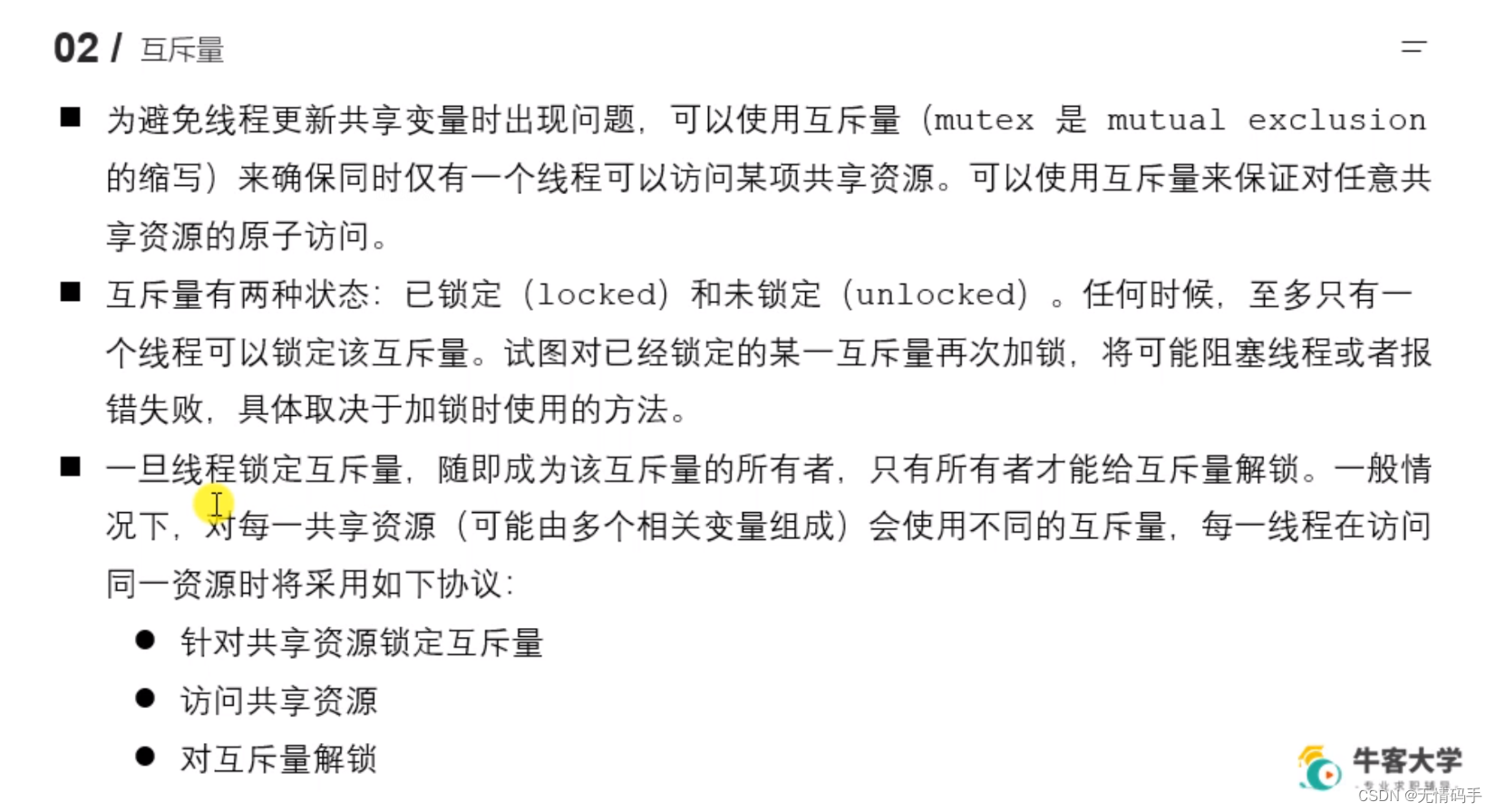
线程拿不到锁,就先等待在这里

互斥量的类型 pthread_mutex_t
int pthread_mutex_init(pthread_mutex_t *restrict mutex, const pthread_mutexattr_t *restrict attr);
- 初始化互斥量
- 参数 :
- mutex : 需要初始化的互斥量变量
- attr : 互斥量相关的属性,NULL
- restrict : C语言的修饰符,被修饰的指针,不能由另外的一个指针进行操作。
pthread_mutex_t *restrict mutex = xxx;
pthread_mutex_t * mutex1 = mutex;
int pthread_mutex_destroy(pthread_mutex_t *mutex);
- 释放互斥量的资源
int pthread_mutex_lock(pthread_mutex_t *mutex);
- 加锁,阻塞的,如果有一个线程加锁了,那么其他的线程只能阻塞等待
int pthread_mutex_trylock(pthread_mutex_t *mutex);
- 尝试加锁,如果加锁失败,不会阻塞,会直接返回。
int pthread_mutex_unlock(pthread_mutex_t *mutex);
- 解锁
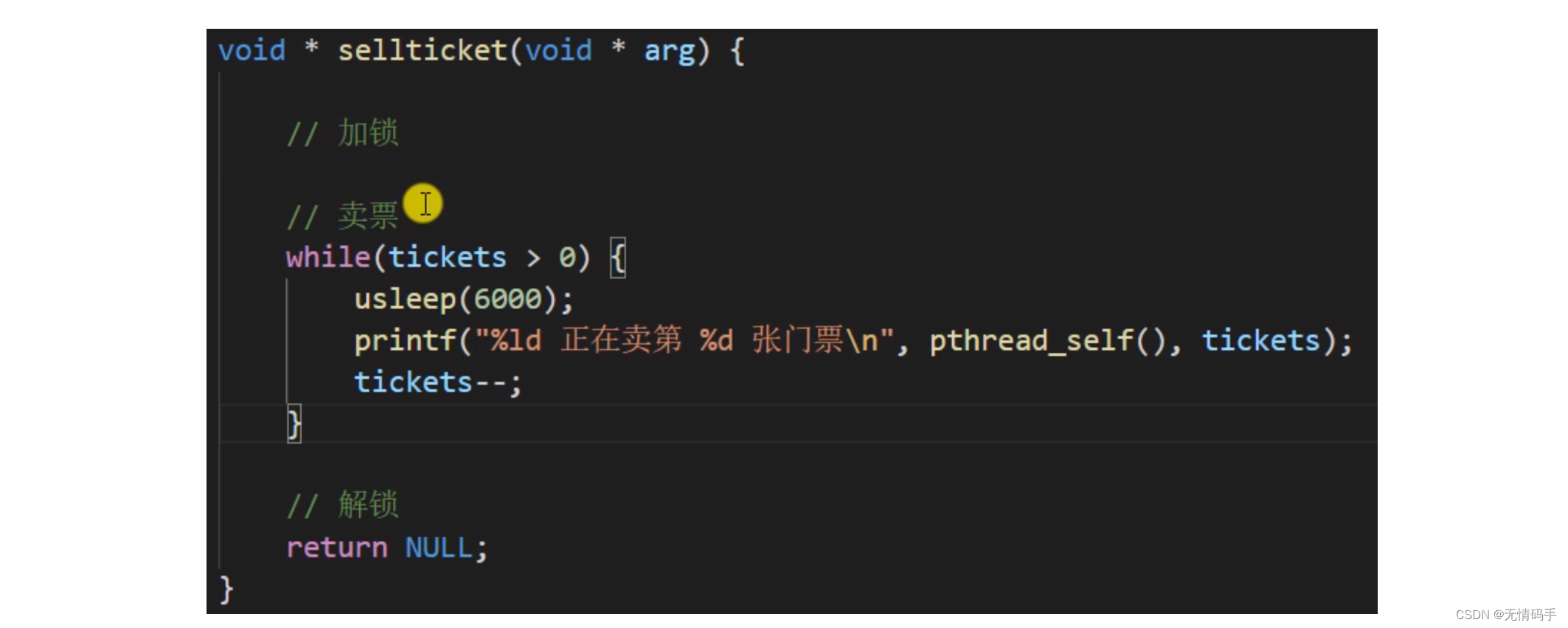
如果把while循环放在加锁和解锁中间,那么这一百张票都是某一个线程卖完的
所以加缩
如果在main函数中创建互斥量,他是局部变量,main()主线程退出之后,局部变量就消失了
所以要放在全局区
在main() pthread_exit(NULL) 后写释放互斥量资源
把锁放到while里
// 卖票
while(1) {
// 加锁
pthread_mutex_lock(&mutex);
if(tickets > 0) {
usleep(6000);
printf("%ld 正在卖第 %d 张门票\n", pthread_self(), tickets);
tickets--;
}else {
// 注意这里也要加一个解锁,因为已经要break了,走不到下面的解锁,所以这里先解一下
// 解锁
pthread_mutex_unlock(&mutex);
break;
}
// 解锁
pthread_mutex_unlock(&mutex);
}
#include <stdio.h>
#include <pthread.h>
#include <unistd.h>
// 全局变量,所有的线程都共享这一份资源。
int tickets = 1000;
// 创建一个互斥量
pthread_mutex_t mutex;
void * sellticket(void * arg) {
// 卖票
while(1) {
// 加锁
pthread_mutex_lock(&mutex);
if(tickets > 0) {
usleep(6000);
printf("%ld 正在卖第 %d 张门票\n", pthread_self(), tickets);
tickets--;
}else {
// 解锁
pthread_mutex_unlock(&mutex);
break;
}
// 解锁
pthread_mutex_unlock(&mutex);
}
return NULL;
}
int main() {
// 初始化互斥量
pthread_mutex_init(&mutex, NULL);
// 创建3个子线程
pthread_t tid1, tid2, tid3;
pthread_create(&tid1, NULL, sellticket, NULL);
pthread_create(&tid2, NULL, sellticket, NULL);
pthread_create(&tid3, NULL, sellticket, NULL);
// 回收子线程的资源,阻塞
pthread_join(tid1, NULL);
pthread_join(tid2, NULL);
pthread_join(tid3, NULL);
pthread_exit(NULL); // 退出主线程
// 释放互斥量资源
pthread_mutex_destroy(&mutex);
return 0;
}
死锁
如果临界区有一千行代码,那么这一千行都在串行,降低了执行效率
所以:拆开临界区加互斥量,提高效率。变成多个临界区和多个互斥量
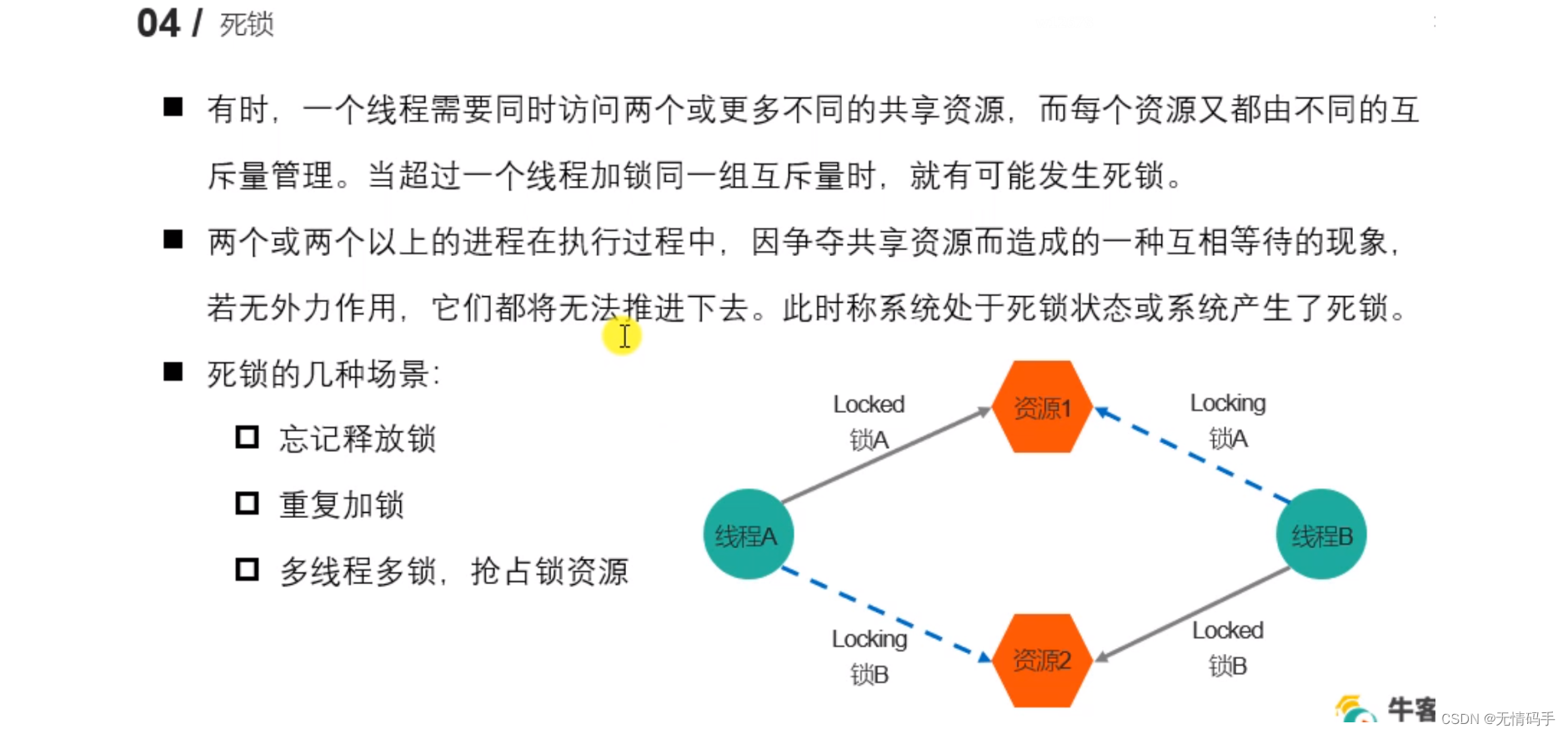
这里的重复加锁是说:重复加相同的锁
pthread_mutex_lock(&mutex);
pthread_mutex_lock(&mutex);
//整个都堵在这了
多线程抢多锁
#include <stdio.h>
#include <pthread.h>
#include <unistd.h>
// 创建2个互斥量
pthread_mutex_t mutex1, mutex2;
void * workA(void * arg) {
pthread_mutex_lock(&mutex1);
sleep(1);
pthread_mutex_lock(&mutex2);
printf("workA....\n");
pthread_mutex_unlock(&mutex2);
pthread_mutex_unlock(&mutex1);
return NULL;
}
void * workB(void * arg) {
pthread_mutex_lock(&mutex2);
sleep(1);
pthread_mutex_lock(&mutex1);
printf("workB....\n");
pthread_mutex_unlock(&mutex1);
pthread_mutex_unlock(&mutex2);
return NULL;
}
int main() {
// 初始化互斥量
pthread_mutex_init(&mutex1, NULL);
pthread_mutex_init(&mutex2, NULL);
// 创建2个子线程
pthread_t tid1, tid2;
pthread_create(&tid1, NULL, workA, NULL);
pthread_create(&tid2, NULL, workB, NULL);
// 回收子线程资源
pthread_join(tid1, NULL);
pthread_join(tid2, NULL);
// 释放互斥量资源
pthread_mutex_destroy(&mutex1);
pthread_mutex_destroy(&mutex2);
return 0;
}
读写锁
多个线程同时读临界资源是没任何问题的
在对数据的读写操作中,更多的是读操作,写操作较少
----> 读写锁
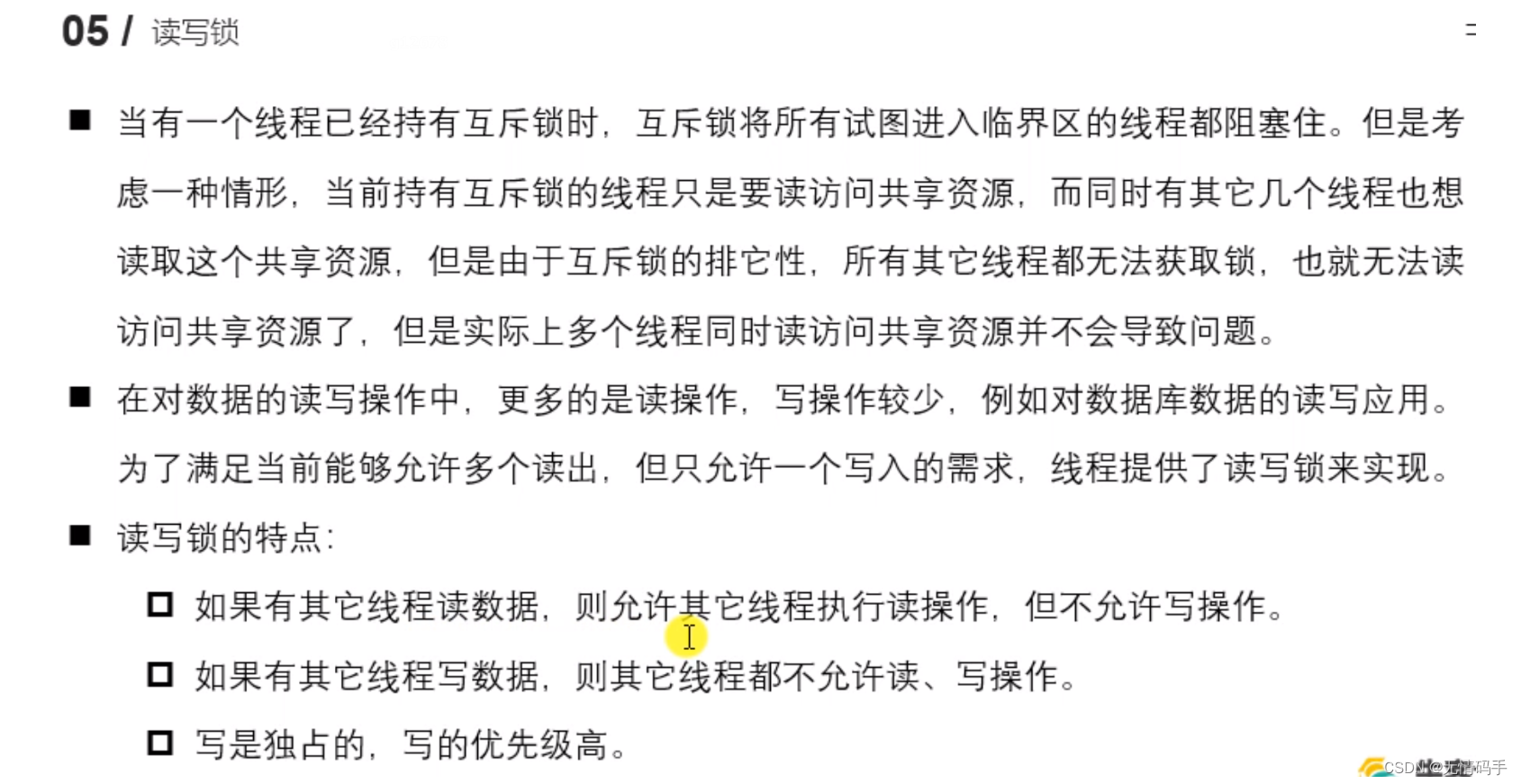
有三个线程要加读锁,一个线程要加写锁,那么先加写锁,其他读锁阻塞
/*
读写锁的类型 pthread_rwlock_t
int pthread_rwlock_init(pthread_rwlock_t *restrict rwlock, const pthread_rwlockattr_t *restrict attr);
int pthread_rwlock_destroy(pthread_rwlock_t *rwlock);
int pthread_rwlock_rdlock(pthread_rwlock_t *rwlock);
int pthread_rwlock_tryrdlock(pthread_rwlock_t *rwlock);
int pthread_rwlock_wrlock(pthread_rwlock_t *rwlock);
int pthread_rwlock_trywrlock(pthread_rwlock_t *rwlock);
int pthread_rwlock_unlock(pthread_rwlock_t *rwlock);
案例:8个线程操作同一个全局变量。
3个线程不定时写这个全局变量,5个线程不定时的读这个全局变量
*/
#include <stdio.h>
#include <pthread.h>
#include <unistd.h>
// 创建一个共享数据
int num = 1;
// pthread_mutex_t mutex;
pthread_rwlock_t rwlock;
void * writeNum(void * arg) {
while(1) {
pthread_rwlock_wrlock(&rwlock);
num++;
printf("++write, tid : %ld, num : %d\n", pthread_self(), num);
pthread_rwlock_unlock(&rwlock);
usleep(100);
}
return NULL;
}
void * readNum(void * arg) {
while(1) {
pthread_rwlock_rdlock(&rwlock);
printf("===read, tid : %ld, num : %d\n", pthread_self(), num);
pthread_rwlock_unlock(&rwlock);
usleep(100);
}
return NULL;
}
int main() {
pthread_rwlock_init(&rwlock, NULL);
// 创建3个写线程,5个读线程
pthread_t wtids[3], rtids[5];
for(int i = 0; i < 3; i++) {
pthread_create(&wtids[i], NULL, writeNum, NULL);
}
for(int i = 0; i < 5; i++) {
pthread_create(&rtids[i], NULL, readNum, NULL);
}
// 设置线程分离
for(int i = 0; i < 3; i++) {
pthread_detach(wtids[i]);
}
for(int i = 0; i < 5; i++) {
pthread_detach(rtids[i]);
}
pthread_exit(NULL);
pthread_rwlock_destroy(&rwlock);
return 0;
}
生产者消费者模型
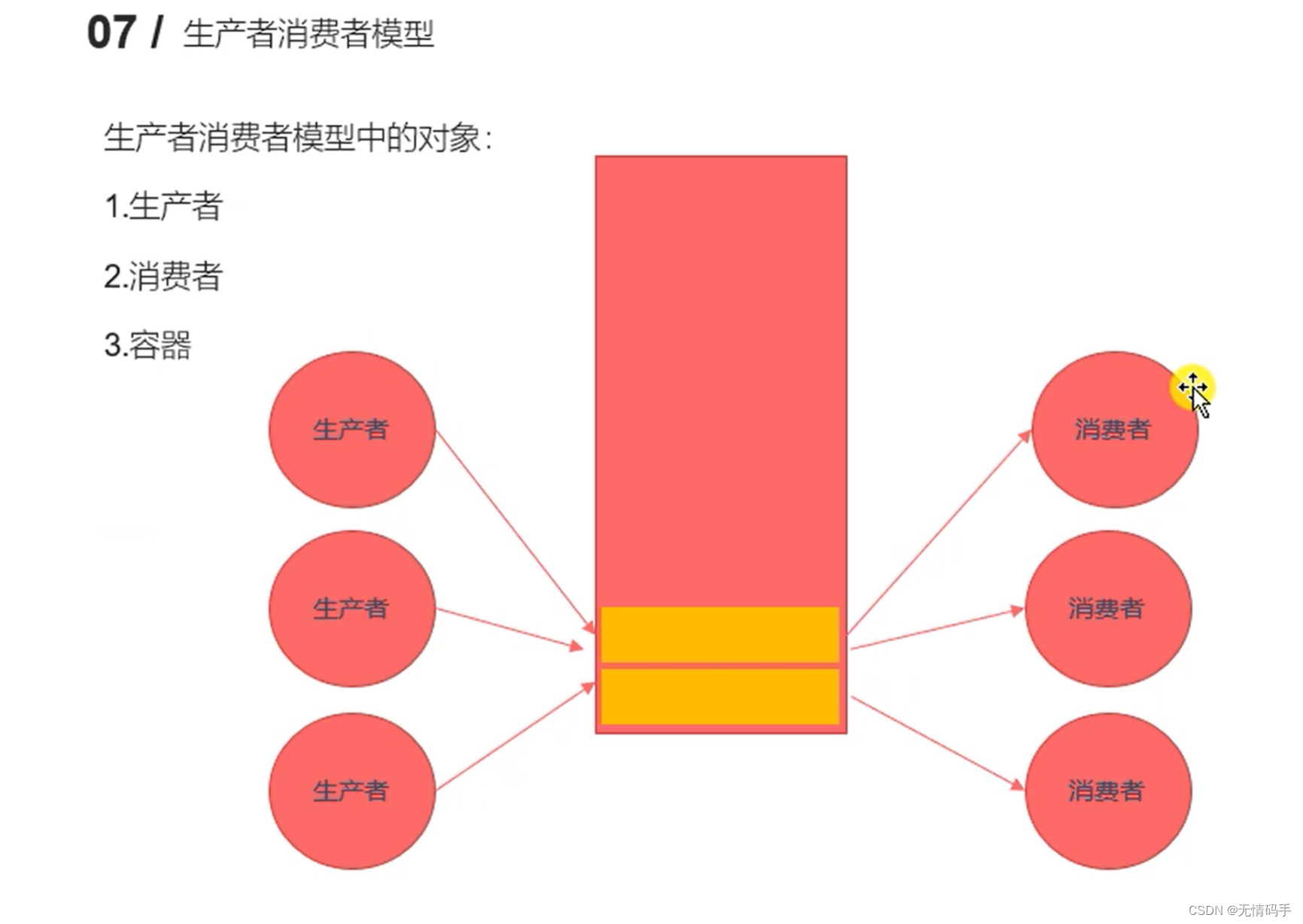
生产者还没生产出来就消费 会出问题、或者生产的多了,已经超过了容量了
使用互斥量、条件变量、信号量
条件变量
现有的问题:
(1)数据不同步 -> 用互斥量处理
如果想用if来判断是否容器空了,不空的话执行,并释放锁
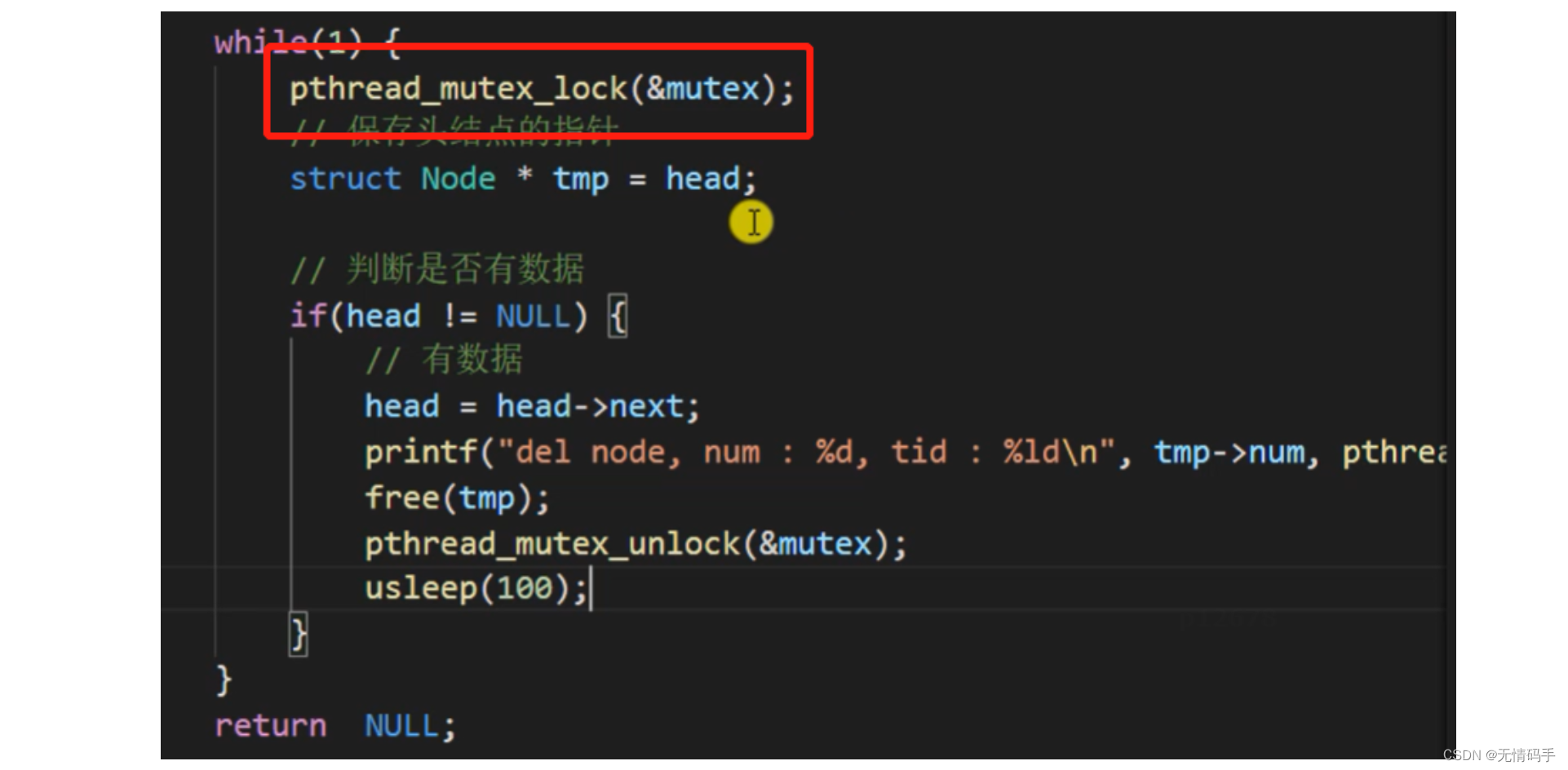
那总会有一个拿到锁后释放不了,因为现在head == NULL了,进入了死循环(死锁)
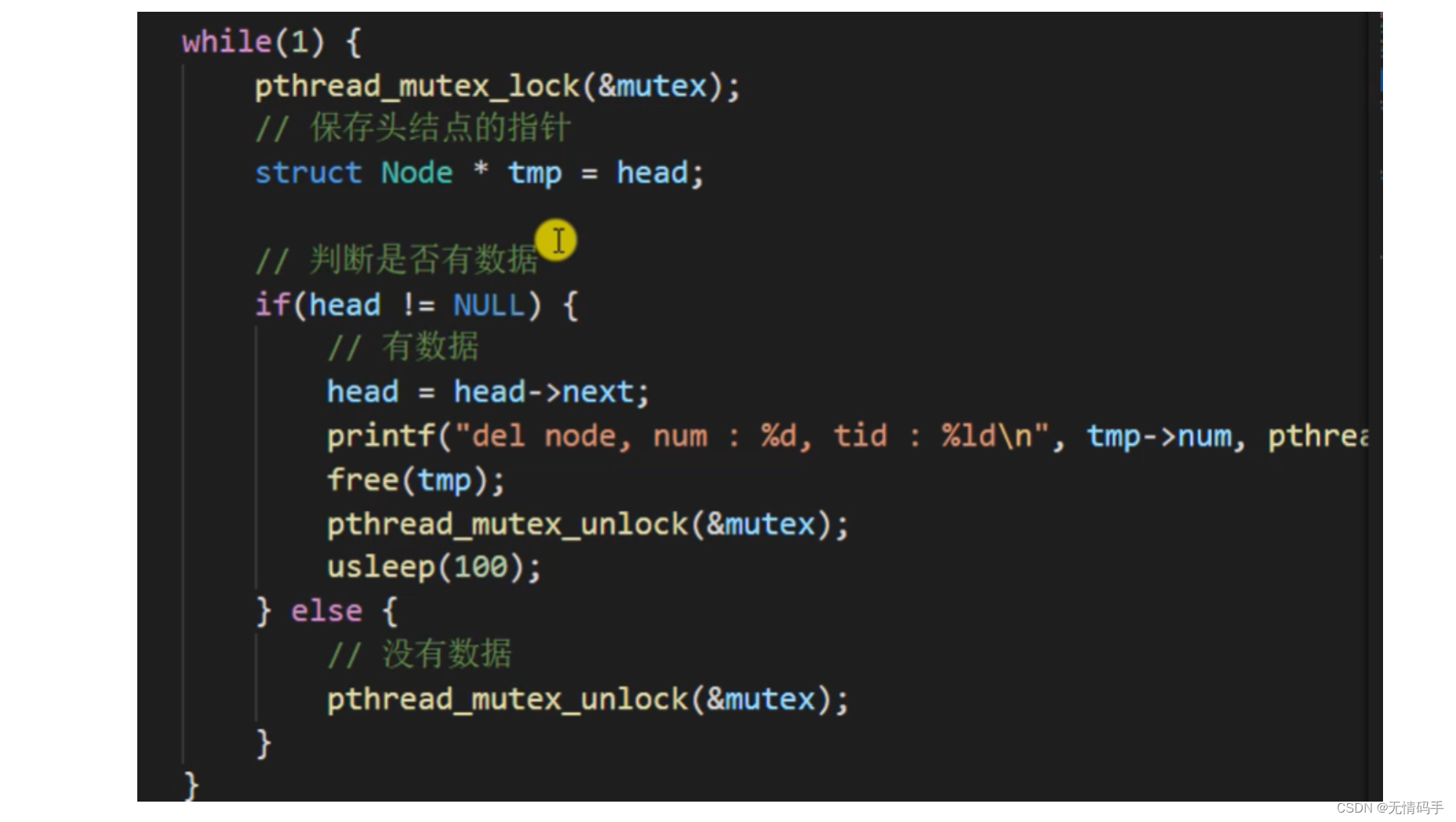
如果这样,可以解决
但是这样不太好,如果一直没有数据,消费者一直不断地判断是不是有数据,效率太低。
正确的情况应该是当消费者没有可消费了的时候,告诉生产者让他生产、生产者生产好之后再告诉他让他消费
条件变量不是锁:它的作用是某个条件满足时,阻塞线程,某个条件满足时、解除阻塞
真正解决同步问题,是靠锁解决,它只是配合锁的一个工具
pthread_cond_t
条件变量的类型 pthread_cond_t
int pthread_cond_init(pthread_cond_t *restrict cond, const pthread_condattr_t *restrict attr);
int pthread_cond_destroy(pthread_cond_t *cond);
int pthread_cond_wait(pthread_cond_t *restrict cond, pthread_mutex_t *restrict mutex);
- 等待,调用了该函数,线程会阻塞。
int pthread_cond_timedwait(pthread_cond_t *restrict cond, pthread_mutex_t *restrict mutex, const struct timespec *restrict abstime);
- 等待多长时间,调用了这个函数,线程会阻塞,直到指定的时间结束。
int pthread_cond_signal(pthread_cond_t *cond);
- 唤醒一个或者多个等待的线程
int pthread_cond_broadcast(pthread_cond_t *cond);
- 唤醒所有的等待的线程
当这个函数调用阻塞的时候,会对互斥锁进行解锁,当不阻塞的,继续向下执行,会重新加锁。
它会先把锁给放了,让生产者拿到,去生产东西,最后生产完了再还回来继续上了锁
pthread_cond_wait(&cond, &mutex);
生产者
void * producer(void * arg) {
// 不断的创建新的节点,添加到链表中
while(1) {
pthread_mutex_lock(&mutex);
struct Node * newNode = (struct Node *)malloc(sizeof(struct Node));
newNode->next = head;
head = newNode;
newNode->num = rand() % 1000;
printf("add node, num : %d, tid : %ld\n", newNode->num, pthread_self());
// 只要生产了一个,就通知消费者消费
// 这边一调用,消费者那里就不阻塞了
pthread_cond_signal(&cond);
pthread_mutex_unlock(&mutex);
usleep(100);
}
return NULL;
}
消费者
void * customer(void * arg) {
while(1) {
pthread_mutex_lock(&mutex);
// 保存头结点的指针
struct Node * tmp = head;
// 判断是否有数据
if(head != NULL) {
// 有数据
head = head->next;
printf("del node, num : %d, tid : %ld\n", tmp->num, pthread_self());
free(tmp);
pthread_mutex_unlock(&mutex);
usleep(100);
} else {
// 没有数据,需要等待
// 当这个函数调用阻塞的时候,会对互斥锁进行解锁,当不阻塞的,继续向下执行,会重新加锁。
pthread_cond_wait(&cond, &mutex);
pthread_mutex_unlock(&mutex);
}
}
return NULL;
}
整体
#include <stdio.h>
#include <pthread.h>
#include <stdlib.h>
#include <unistd.h>
// 创建一个互斥量
pthread_mutex_t mutex;
// 创建条件变量
pthread_cond_t cond;
struct Node{
int num;
struct Node *next;
};
// 头结点
struct Node * head = NULL;
void * producer(void * arg) {
// 不断的创建新的节点,添加到链表中
while(1) {
pthread_mutex_lock(&mutex);
struct Node * newNode = (struct Node *)malloc(sizeof(struct Node));
newNode->next = head;
head = newNode;
newNode->num = rand() % 1000;
printf("add node, num : %d, tid : %ld\n", newNode->num, pthread_self());
// 只要生产了一个,就通知消费者消费
pthread_cond_signal(&cond);
pthread_mutex_unlock(&mutex);
usleep(100);
}
return NULL;
}
void * customer(void * arg) {
while(1) {
pthread_mutex_lock(&mutex);
// 保存头结点的指针
struct Node * tmp = head;
// 判断是否有数据
if(head != NULL) {
// 有数据
head = head->next;
printf("del node, num : %d, tid : %ld\n", tmp->num, pthread_self());
free(tmp);
pthread_mutex_unlock(&mutex);
usleep(100);
} else {
// 没有数据,需要等待
// 当这个函数调用阻塞的时候,会对互斥锁进行解锁,当不阻塞的,继续向下执行,会重新加锁。
pthread_cond_wait(&cond, &mutex);
pthread_mutex_unlock(&mutex);
}
}
return NULL;
}
int main() {
pthread_mutex_init(&mutex, NULL);
pthread_cond_init(&cond, NULL);
// 创建5个生产者线程,和5个消费者线程
pthread_t ptids[5], ctids[5];
for(int i = 0; i < 5; i++) {
pthread_create(&ptids[i], NULL, producer, NULL);
pthread_create(&ctids[i], NULL, customer, NULL);
}
for(int i = 0; i < 5; i++) {
pthread_detach(ptids[i]);
pthread_detach(ctids[i]);
}
while(1) {
sleep(10);
}
pthread_mutex_destroy(&mutex);
pthread_cond_destroy(&cond);
pthread_exit(NULL);
return 0;
}
信号量(信号灯)
类似于条件变量,都是用于阻塞线程的(但是一样地,没有办法多线程数据安全哦)
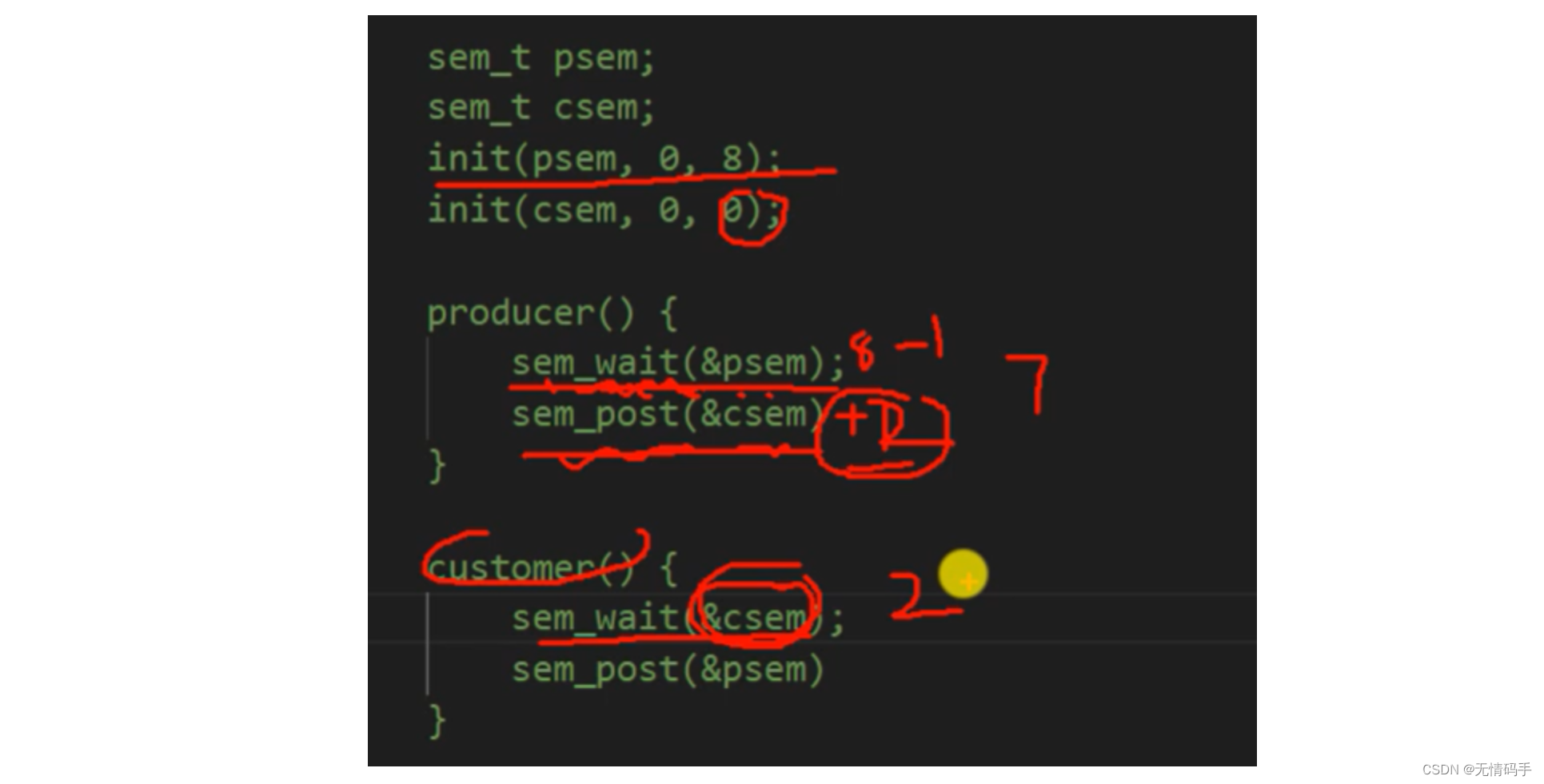
生产者一开始是8,是>0的,所以它要去生产 所以-1
消费者csem就会+1,可以消费一个
如果生产者生产了两个,那就csem+2,消费者可以消费2个
如果不给生产者加回来,那生产者到了0的时候,就不能再生产了
生产者的可以理解为容量
信号量的类型 sem_t
int sem_init(sem_t *sem, int pshared, unsigned int value);
- 初始化信号量
- 参数:
- sem : 信号量变量的地址
- pshared : 0 用在线程间 ,非0 用在进程间
- value : 信号量中的值
int sem_destroy(sem_t *sem);
- 释放资源
int sem_wait(sem_t *sem);
- 对信号量加锁,调用一次对信号量的值-1,如果值为0,就阻塞
int sem_trywait(sem_t *sem);
int sem_timedwait(sem_t *sem, const struct timespec *abs_timeout);
int sem_post(sem_t *sem);
- 对信号量解锁,调用一次对信号量的值+1
int sem_getvalue(sem_t *sem, int *sval);
sem_t psem;
sem_t csem;
init(psem, 0, 8);
init(csem, 0, 0);
producer() {
sem_wait(&psem);
// 锁的操作和同步操作放在这中间
sem_post(&csem)
}
customer() {
sem_wait(&csem);
// 锁的操作和同步操作放在这中间
sem_post(&psem)
}
锁是保证不能让同时操作,信号量/条件变量是保证值要在一个范围内,比如说不能大于最大容量了,也不能小于0了…
#include <stdio.h>
#include <pthread.h>
#include <stdlib.h>
#include <unistd.h>
#include <semaphore.h>
// 创建一个互斥量
pthread_mutex_t mutex;
// 创建两个信号量
sem_t psem;
sem_t csem;
struct Node{
int num;
struct Node *next;
};
// 头结点
struct Node * head = NULL;
void * producer(void * arg) {
// 不断的创建新的节点,添加到链表中
while(1) {
sem_wait(&psem);
pthread_mutex_lock(&mutex);
struct Node * newNode = (struct Node *)malloc(sizeof(struct Node));
newNode->next = head;
head = newNode;
newNode->num = rand() % 1000;
printf("add node, num : %d, tid : %ld\n", newNode->num, pthread_self());
pthread_mutex_unlock(&mutex);
sem_post(&csem);
}
return NULL;
}
void * customer(void * arg) {
while(1) {
sem_wait(&csem);
pthread_mutex_lock(&mutex);
// 保存头结点的指针
struct Node * tmp = head;
head = head->next;
printf("del node, num : %d, tid : %ld\n", tmp->num, pthread_self());
free(tmp);
pthread_mutex_unlock(&mutex);
sem_post(&psem);
}
return NULL;
}
int main() {
pthread_mutex_init(&mutex, NULL);
sem_init(&psem, 0, 8);
sem_init(&csem, 0, 0);
// 创建5个生产者线程,和5个消费者线程
pthread_t ptids[5], ctids[5];
for(int i = 0; i < 5; i++) {
pthread_create(&ptids[i], NULL, producer, NULL);
pthread_create(&ctids[i], NULL, customer, NULL);
}
for(int i = 0; i < 5; i++) {
pthread_detach(ptids[i]);
pthread_detach(ctids[i]);
}
while(1) {
sleep(10);
}
pthread_mutex_destroy(&mutex);
pthread_exit(NULL);
return 0;
}
条件变量wait、signal函数是在加锁解锁里面
信号量的操作是在加锁解锁外面





















 387
387











 被折叠的 条评论
为什么被折叠?
被折叠的 条评论
为什么被折叠?








